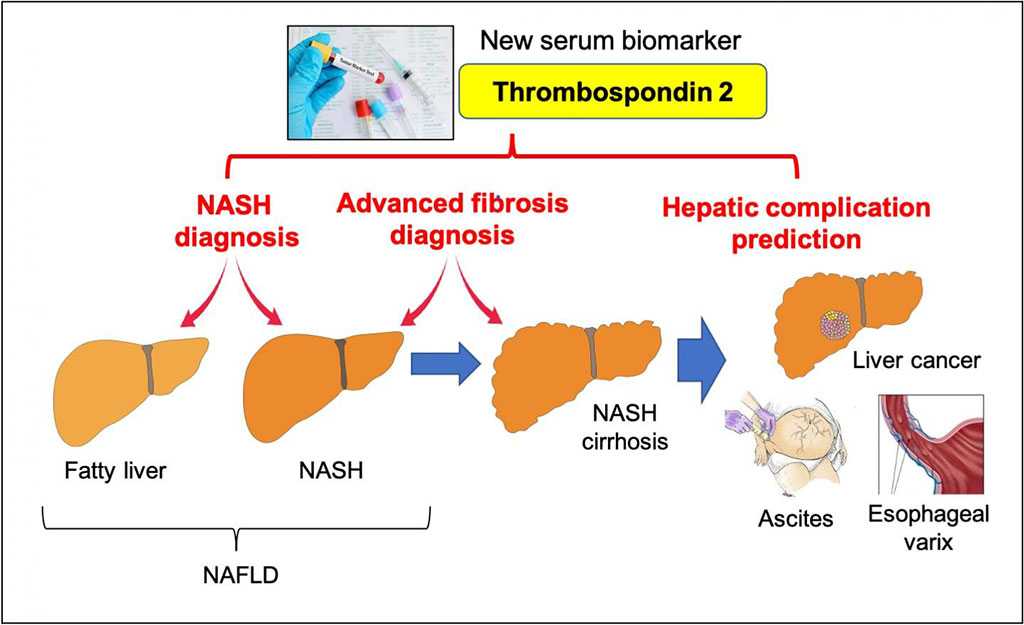Serum Thrombospondin 2 Identified as Biomarker for Patients at Risk of Nonalcoholic Fatty Liver Disease
By LabMedica International staff writers
Posted on 28 Jun 2021
Serum levels of the glycoprotein thrombospondin 2 (TSP-2) were shown to be a useful biomarker for non-alcoholic steatohepatitis (NASH) and advanced fibrosis diagnosis in nonalcoholic fatty liver disease (NAFLD) patients.Posted on 28 Jun 2021
NAFLD is the most common liver disorder worldwide and leading cause of chronic liver disease. The disease affects approximately 25% of the world's population. It is particularly common in developed nations, such as the United States, and affected about 75 to 100 million Americans in 2017. There are two types of NAFLD: non-alcoholic fatty liver (NAFL) and non-alcoholic steatohepatitis (NASH). Non-alcoholic fatty liver usually does not progress to liver damage or NASH. NASH includes both a fatty liver and liver inflammation. It may lead to complications such as cirrhosis, liver cancer, liver failure, or cardiovascular disease. NAFLD displays a strong genetic component, and inherited forms of have been suspected. However, the molecular mechanisms of hereditary NAFLD have not been described.

Image: Thrombospondin 2 is a new diagnostic and prognostic serum biomarker in NAFLD (Photo courtesy of Osaka University)
Over 90% of obese, 60% of diabetic, and up to 20% normal-weight people develop NAFLD. Genetic factors are known to play a major role in determining the likelihood of developing NAFLD. Since there are no methods for early detection of the disease, researchers have been searching for early biomarkers that could be used for this purpose.
In this regard, investigators at Osaka University (Japan) performed global RNA sequencing of liver tissue from 98 patients with biopsy-proven NAFLD. In this way they were able to analyze the transcriptome, the entire array of messenger RNA (mRNA) molecules derived from expression of the genome.
Results revealed that transcriptomic analysis identified proteins upregulated in NASH and/or advanced fibrosis, including matricellular glycoprotein thrombospondin 2 (TSP-2). This protein is encoded by the THBS2 gene and belongs to the thrombospondin protein family. It is a disulfide-linked homotrimeric glycoprotein that mediates cell-to-cell and cell-to-matrix interactions. In the current study, it was found that THBS2 expression level in the liver showed the highest areas under the receiver operating characteristic curves for diagnosing NASH and advanced fibrosis, respectively. THBS2 was associated with extracellular matrix and collagen biosynthesis, platelet activation, caspase-mediated cleavage of cytoskeletal proteins, and immune cell infiltration.
Serum TSP-2 expression measured in 213 patients with biopsy-proven NAFLD was significantly higher in NASH than in NAFL, and increased parallel to fibrosis stage. Serum TSP-2 level and platelet count were independent predictors of NASH and advanced fibrosis. Serum TSP-2 levels could stratify NAFLD patients according to the risk of hepatic complications, including liver cancer.
"We obtained liver tissue from over 300 Japanese and European patients with biopsy-proven NAFLD and performed global RNA sequencing,” said first author Dr. Kazuhiro Kozumi, a researcher in gastroenterology and hepatology at Osaka University. "Remarkably, from the protein patterns we could not only distinguish NASH from NAFL, but also determine the molecular hallmarks of NASH pathology. Specifically, we pinpointed that levels of thrombospondin 2 (TSP-2), a glycoprotein encoded by the THBS2 gene, were increased in both NASH and advanced fibrosis."
Senior author Dr. Tetsuo Takehara, professor of gastroenterology and hepatology at Osaka University, said, "Both hepatic THBS2 gene expression in the liver and serum protein levels of TSP-2 can diagnose cases of NASH and/or advanced fibrosis. A simple and convenient blood test can provide a clinically useful early warning system for complications of NAFLD and inform lifestyle modifications or other interventions that may alter the course of the disease and improve the prognosis."
The study was published in the June 9, 2021, online edition of the journal Hepatology.
Related Links:
Osaka University













